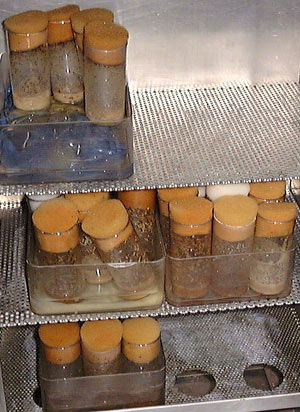
Typical Drosophila vials. Keeping flies over damp paper in a dedicated cabinet helps maintain humidity, and prevents contamination from wild flies.
Why a regime?
Looking after Drosophila is quite easy when you get the hang of it. When cultures crash it's usually because they were left unattended for too long. The life span (just like the development time) is temperature dependent, and does not much exceed 2 weeks as a fly. It is critical to follow a careful regime to allow maximum production. This can take a few minutes each week and that's it. HOWEVER, miss a week and your yield will be drop, miss 2 and you may well loose your cultures! If flies are left too long over old media, they will also starve, and provide a poor snack for the fish. If you can not attend to the flies, its best to keep them cool, slowing down their life cycle (20 deg C) until you can tend to them again.
In general flies should be kept at around 25-28 degrees C. This provides a quick turnover of flies for feeding and allows a weekly regime to be followed. They also like a relatively high humidity; If yours are not kept in a humid room, consider keeping the vials in half a centimeter of water.
So how does the regime work?
The vials that the flies inhabit are separated into 3 categories:
- The present generation of adult flies - laying eggs for future generations (3-4 vials - top shelf of picture)
- Vials containing chrysalised larvae, and newly emerged flies. (10-20 vials - middle shelf of picture)
- Flies or larvae for feeding fish (3-4 vials - bottom shelf of picture).
Once per week newly emerged flies are collected from 2. These are placed in fresh vials, and are designated 1, the present generation. After 3-4 days these flies are moved again, onto new media 3. The old vials (which are loaded with eggs or very young larvae) go back in 2, to make future generations. Once the week has passed, the flies making the present generation can be fed to your fish, and their vials may either go back into 2, or be left for a few days to provide larvae for feeding (see part 5 - feeding fish). Of course a new generation of adult flies is again collected from 2 at the same time.
In hot weather, and if things are going well, you will soon have a lot of flies. On the other hand, you may struggle to breed enough to satisfy your fish. But always avoid feeding newly emerged flies to your fish, even if you have no shortage of flies 'coming through'. Newly collected flies may well be hungry. It's always a good idea to place them over fresh media with added brewers yeast for 24 hours before feeding them to fish, ensuring they are plump and healthy before feeding to your killies.
There are many advantages of keeping to a strict regime such as this:
- Each vial will contain only flies/larvae of approximately the same age, resulting in eclosion (hatching of the adult fly) over a relatively short period. This reduces the time you have to hang onto older vials-making fly collection easier and lessening the chances of mold.
- The longer flies are kept on the same media, the more runny it becomes- if the flies are collected after a 3-4 days, it will still be quite solid. Runny media can drown flies, stick them down and goes everywhere when the jar is inverted.
- All flies will have reached sexual maturity and have reproduced before being fed.
Fruit fly cultures for sale
Killi.co.uk is funded by its visitors. When you buy through links on our site we may earn an affiliate commission. For more info see
terms and conditions.
Dover, Pennsylvania, 173**, UNITED STATES OF AMERICA
$130
This 16 pack of Hydei Fruit Fly cultures is the perfect addition to any reptile or dart frog owner's collection. These cultures provide a nutritious and tasty food source for your pets without the hassle of dealing with live insects. The flies are easy to maintain and will last for several weeks, ensuring that your pets are well-fed and healthy.
With free shipping included, this is a great deal that you don't want to miss out on. Whether you're a seasoned reptile owner or a new dart frog ...
more
Durham, NC, UNITED STATES OF AMERICA
$22
Rohnert Park, California, 949**, UNITED STATES OF AMERICA
$4
This product is perfect for those who love to create unique and handcrafted items. The pack contains 8 oz of Wood Wool Excelsior, which is perfect for packing fragile items or even as a decorative material. The product is made from high-quality materials and is designed to provide maximum comfort and protection for your reptile pets.
With its exceptional quality and versatility, this product is a must-have for all crafting enthusiasts. It is ideal for creating various items, from fruit flies...
more
Eureka, California, 955**, UNITED STATES OF AMERICA
$16
Fresh, healthy fruit fly cultures grown on a premium, nutrient-rich medium for strong growth and reliable production
Each culture is started with a generous number of flies to ensure quick establishment and steady output
Perfect For:
?? Dart frogs & tree frogs
?? Baby chameleons
?? Small geckos (crested, gargoyle, day geckos, leachies)
?? Praying mantises & jumping spiders
?? Betta & nano fish
?? Isopods, springtails, & bioactive tanks love spent ...
more
Cleveland, Georgia, 305**, UNITED STATES OF AMERICA
$40
??PLEASE READ BEFORE PURCHASING??
(WHAT YOU RECEIVE)
-------------------------------------------------------------------------------------
FRUIT FLY: Drosophila Hydei (flightless)
SIZE: 1 / 8?? inches (larger than melanogaster fruit flies)
COUNT: 50+ (will produce prolifically)
(BASIC INFO)
-------------------------------------------------------------------------------------
LIVE FOOD SOURCE FOR: Dart Frogs, Jumping Spiders, Praying
Mantis, Mantids, Morning Geckos, ...
more